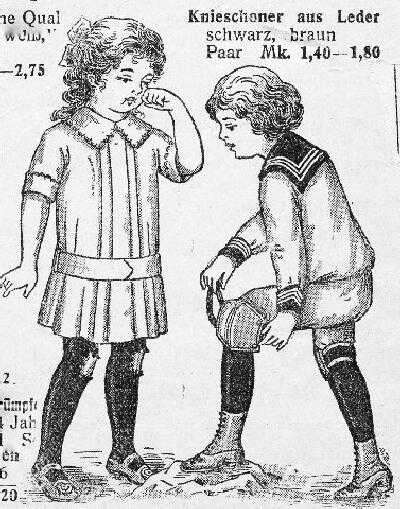
Figure 1.--Here the illustration depicts the problem with long stockings. The gikl has worn holes in her stockings. And the solution is leather knee pads whixh the boy is shown wearing. |

|
Here we see leather knee pads. The pads were designed to deal with a problem associated with long stockings. Active children, especially boys, would wear out the knees well before the rest of the stockings. Sometimes they would wear holes in a brand new pair of stockings. This was a problem, of course, not expridnced with knee socks or ankile socks. Here we see see the boy wearing the leather knee pads protecting the knees of long stockings. We don't think that these knee protectors were very common because we don't see them in the photographic record. The catalog describes them as Knieschoner aus Leder.
We do not know the name of the catalog. We have found some German catalog items, but they are only fragments and not identified. We do not know what catalog they came from. We do not even know if it was a mail order company catalog or a local store catalog. The style suggests it was not a newspaper ad. The style of the illustrations may eventually help us identify it. Hopefully our German readers will have some insights as go the identity of the catalog and the date.
The catalog image we found here was also not dated. We also do mot know the date of the catalog. We believe it might be some time in the 1900s, but we are not enirely sure about that. The style of the catalog presentations suggests the 1900s to us, but the 1910s is possible.
As in America, long stockings were very commonly worn in Germany during the early 20th century. Black long stockings were particularly popular and worn by both voys and girls. The most prominent country where long stockings were worn was Germany. Long stockings were worn in Germany in the late 19th century much as they were in many other European countries. Most boys wearing keepants wore them. We have, however, limited information on German boys' clothes during the 19th century. We have more informtion in the 20th century. There were, however, great geographical, cultural and social differences concerning the wearing of long stockings.After World War II, long stockings became less cinnon for older bioys, but children in primary schools still commonly wore them--especially during the cooler weather. In this respect, Germany diuffered from trends in Western Europoe.
Leather knee pads were designed to deal with a problem associated with long stockings. The catalog describes them as Knieschoner aus Leder.Active children, especially boys, would wear out the knees well before the rest of the stockings. Long stockings are today, because theyare no longer worn, associated with the Swedish child literary chararacter--Pipi Longstockings. And she is always depicted wearing long stockings with holes in them. Sometimes they would wear holes in a brand new pair of stockings. This was a problem, of course, not expridnced with knee socks or ankile socks. Here we see see the boy wearing the leather knee pads protecting the knees of long stockings. We don't think that these knee protectors were very common because we don't see them in the photographic record. In fact we have yet to find a single example in the photograohic record. This is a good example of how the photigraphic record and catalog information is best used in comination. The photographic record is the best source of information on what was actually worn. The catalogs provide information on sizes, colors, material, and detailing that is often not available from the photographic record along.
A German reader writes, "I myself as a little boy can remember well having (to have to wear) such knee pads in the 1940s (up to about 14 years of age). They were home-made. An aunt was running a small
leather pocket manufactury. And there, always, some small leather discards were available. My mother got some and added some strings to bind them above and below the knees from behind. Accepted, they were very practical as "Kneeschoner" ('schonen' is the German verb for 'protecting' the long stockings). I didn't like them. Coming home from school and after having done the school exercices I had to put them on before going out to plsy or even just hanging around in my room." About other boys our reader writes, "I don't know. I can' t remember whether my playmates had these pads. I was the eldest and my mother was rather dominant. As the knee pads where mostly used at home where the kids played on the floor one didn't see them on the streets." This may well explain why you also don't see them in the photographic record.
Navigate the Boys' Historical Clothing catalog/magazine pages:
[Return to the Main German 1900s catalog page]
[Main photo/publishing page]
[Store catalogs]
[Fashion magazines]
Navigate the Boys' Historical Clothing Web Site:
[Introduction]
[Activities]
[Biographies]
[Chronology]
[Clothing styles]
[Countries]
[Topics]
[Bibliographies]
[Contributions]
[FAQs]
[Glossaries]
[Images]
[Links]
[Registration]
[Tools]
[Boys' Clothing Home]
Navigate the Boys' Historical Clothing Web Site:
[Sailor suits]
[Sailor hats]
[Buster Brown suits]
[Eton suits]
[Rompers]
[Tunics]
[Smocks]
[Pinafores]
